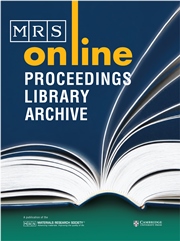Article contents
Leaching Behavior of Edta In A Silica Sol-GelMatrix
Published online by Cambridge University Press: 21 February 2011
Abstract
Ethylene diamine tetra-acetic acid (EDTA) doped silica gels were made by thesol-gel process for the potential application as a filter for heavy metalions in wastewater. The behavior of the organic molecule in the matrix wasstudied by investigating the percentage of EDTA leached out with a variationin the timing of addition of the EDTA molecule into the starting silica gelsolution. Leach tests using water as the medium were performed for 2, 12 and24 hours in order to determine the amount of EDTA trapped in the pores or inthe matrix. A minimum amount of EDTA leached from the gels was detected inthe samples to which EDTA was added 4 hours after initial hydrolysis ofTEOS. This result was correlated to having a greater percentage of porevolume in the range of 15–20 Å, which was further substantiated with densitymeasurements. The physical changes in the silica matrix altering the porevolume distribution were attributed to the addition of the water into whichthe EDTA molecule was initially dissolved.
Information
- Type
- Research Article
- Information
- Copyright
- Copyright © Materials Research Society 1998
References
REFERENCES
- 1
- Cited by

